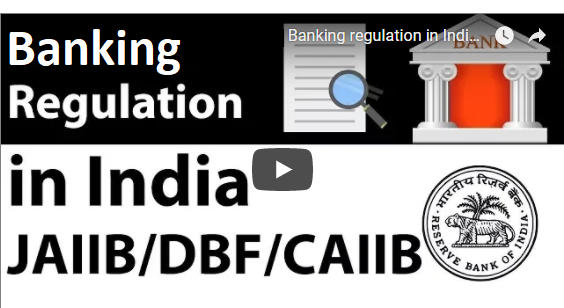Table of Contents
Indian Financial System – BANKING REGULATION
2.3.7 Regulator and supervisor of payment and settlement systems
- The central bank of any country is usually the driving force in the development of national payment systems
- The Reserve Bank of India as the central bank of India has been playing this developmental role and has taken several initiatives for Safe, Secure, Sound, Efficient, Accessible and Authorised payment systems in the country
- In India, the payment and settlement systems are regulated by the Payment and Settlement Systems Act, 2007 (PSS Act) which was legislated in December 2007. The PSS Act as well as the Payment and Settlement System Regulations, 2008 framed thereunder came into effect from August 12, 2008
Payment Systems
The Reserve Bank has taken many initiatives towards introducing and upgrading safe and efficient modes of payment systems in the country to meet the requirements of the public at large.
Various systems used are :-
- Retail payment systems :- cheque clearing system, electronic fund transfer through NEFT ,settlement of card payments and bulk payments such electronic clearing system (debit and credit)
- Large value systems :- real time gross settlement ,securities settlement system for the government securities market ,foreign exchange clearing : for transactions involving foreign currency
2.3.8 Maintaining financial stability
- Conduct of the macro prudential surveillance of the financial system
- Developing model for assessing financial stability in going forward
- Preparation of half yearly financial stability reports
- Development of database of key variables which could impact financial stability
- Development of a time series of a core set of financial indicators
- Conduct of systematic stress tests to assess resilience
Financial stability report
- First was published in march 2010

What is Financial Stability and Development Council (FSDC)?
- The FSDC was envisaged for performing two sets of core functions. First is to perform as an apex level forum to strengthen and institutionalize the mechanism for maintaining financial stability
- Second is for enhancing inter-regulatory coordination and promoting financial sector development in the country.
Composition of FSDC
- The Chairman of the Council is the Finance Minister and its members include the heads of financial sector Regulators (RBI, SEBI, PFRDA, IRDA & FMC {now with SEBI}) Finance Secretary and/or Secretary, Department of Economic Affairs, Secretary, Department of Financial Services, and Chief Economic Adviser.
Function of the FSDC:
- It will focus on financial literacy and financial inclusion.
It aims strengthening and institutionalizing the mechanism of financial stability and development. - It will monitor macro-prudential supervision of the economy. It will assess the functioning of the large financial conglomerates
It will address intra regulatory coordination issues.
The FSDC Sub Committee Chaired by the Governor of the RBI
- An important wing of the FSDC, in terms of functional responsibility is the Sub committee chaired by the Governor of the RBI
It meets more often than the full Council - All the members of the FSDC are also the members of the Sub-committee. Additionally, all four Deputy Governors of the RBI and Additional Secretary, DEA, in charge of FSDC, are also members of the Sub Committee
Other wings within the FSDC
the Inter regulatory technical group, Technical Group on financial inclusion and financial literacy, Inter regulatory forum for monitoring financial conglomerates (IRF-FC), Early Warning Group, Working Group on resolution regime for financial institutions and the Macro Financial and Monitoring Group
2.3.9 Developmental role
Deposit insurance and credit guarantee corporation (1962)
Unit trust of India (1964)
Industrial development bank of India (1964)
National bank for agriculture and rural development (1982)
Discount and finance house of india(1988)National housing bank (1989)
Securities and trading corporation of india (1994)
Directed credit for lending to priority sector and weaker sections
Lead bank scheme
Sector specific refinance
Strengthening and supporting small local banks
Financial inclusion
2.4 Regulatory restrictions on lending
No advance or loan can be granted against the security of the bank’s own shares
No bank can hold shares in a company
a) As pledgee or mortgagee in excess of the limit of 30% of the paid-up capital of that company or 30% of the bank’s paid up capital and reserves ,whichever is less (sec 19 ii of BRA)
b) In the management of which MD or ,manager of the bank is interested (sec 19 iii of BRA)
Bank’s aggregate investment in shares ,CD ,bonds, etc. should not exceed the limit of 40% of bank’s net owned funds at the end of the previous year
No bank should grant loans against
a) CD & b) Indian depository receipts
Banks should desist from sanctioning loans against FD’s issued by other banks
Banks should adhere to the RBI guidelines (level of credit ,margin and interest rate etc.)
No additional facilities should be granted by any bank/FIs to the listed willful defaulters.
In addition to the entrepreneurs /promoters of companies where banks /FIs have identified siphoning /diversion of funds, misrepresentation, falsification of accounts and fraudulent transactions should be debarred from institutional finance from the SCB’s
RBI has advised the banks to fix limits on their exposure to specific industry or sectors and has prescribed regulatory limits on banks’ exposure to individual and group borrowers in India
15% of capital funds in case of single borrower
40% in case of borrower groups
2.5 Inclusion of URB’s in the 2nd schedule of RBI act 1934
Financial criteria
a)DTL of not less that Rs. 750cr on a continuous basis for one year
b)CRAR of 12%
c)Continous net profit for the previous 3 years
d)Gross NPA’s not exceeding 5% e) Compliance with CRR and SLR requirements and
f) No major regulatory and supervisory concerns\






















 WhatsApp
WhatsApp